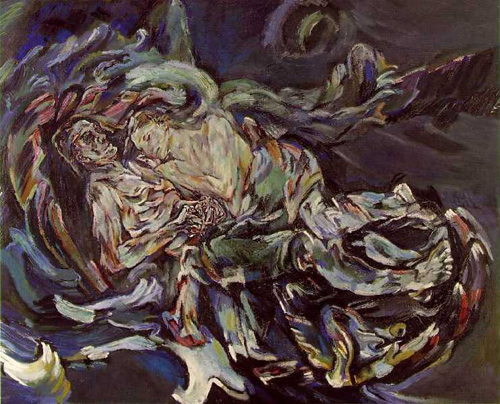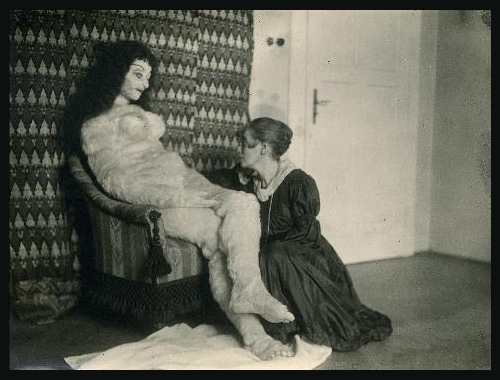I wonder whether any of you have seen the film Lars and the Real Girl? It was a sweet, chaste sort of film considering its casting of a Real Doll as the female lead, and though I enjoyed it I couldn’t help but spend its entire length being reminded of the altogether less sweet, less chaste, true life corollary of “Oscar and the Alma Doll.”
The synopsis of this tale might go as follows- In 1911 Viennese artist Oskar Kokoschka (or as the German press referred to him “der tolle Kokoschka”) meets Alma Mahler, the widow of composer Gustav Mahler. A relationship begins consisting mainly of hot sex and expressionist painting. Or “the good life” as it’s sometimes called. Oscar, for his part, falls obsessionally, passionately, possessively hard. Alma... not so much.

By 1913 their relationship is strained-
Quote: “They travelled to Italy together, and on one occasion visited the Naples aquarium. Kokoschka watched an insect sting and paralyse a fish, before devouring it, and at once associated the scene with the woman by his side.” -Edward Lucie-Smith, Lives of the Great 20th Century Artists.
Alma became pregnant and, against Oscar’s wishes, has the child aborted. Oscar is crushed. At the outbreak of World War I in 1914 he volunteers and serves with the Austrian army. In 1915, while stationed in Russia, Oscar receives a serious injury via unfriendly bayonet. He returns from the front to find Alma has married an old flame, architect Walter Gropius. Oscar is double-crushed. In 1918, underlining military doctor’s previous assessment of him as “mentally unstable,” he reacts to all this heartache the way any good, obsessive, expressionist painter would-
Detailed physical descriptions and full-scale drawing in hand, he commissions the doll-maker Hermine Moos to create a life-sized Alma Mahler doll to her exact, anatomically accurate specifications.
Quote: “Yesterday I sent a life-size drawing of my beloved and I ask you to copy this most carefully and to transform it into reality. Pay special attention to the dimensions of the head and neck, to the ribcage, the rump and the limbs. And take to heart the contours of body, e.g., the line of the neck to the back, the curve of the belly. Please permit my sense of touch to take pleasure in those places where layers of fat or muscle suddenly give way to a sinewy covering of skin. For the first layer (inside) please use fine, curly horsehair; you must buy an old sofa or something similar; have the horsehair disinfected. Then, over that, a layer of pouches stuffed with down, cottonwool for the seat and breasts. The point of all this for me is an experience which I must be able to embrace! Can the mouth be opened? Are there teeth and a tongue inside? I hope so!” -Oscar Kokoschka

The doll takes Hermine Moos 6 months to complete. Oscar is impatient.
Quote: “I would die of jealousy if some man were allowed to touch the artificial woman in her nakedness with his hands or glimpse her with his eyes! When shall I be able to hold all this in my hands?” -Oscar Kokoschka
Oscar had by this time already found another playmate. A Serving-maid by the name of Hulda. But though she poses for him, calls him captain, carves his initials into her breast, and offers herself to him bodily, Oscar remains preoccupied.
Quote: “I was preoccupied with anxious thoughts about the arrival of the doll, for which I had bought Parisian clothes and underwear. I wanted to have done with the Alma Mahler business once and for all, and never again to fall victim to Pandora’s fatal box, which had already brought me so much suffering.” -Oscar Kokoschka
In February of 1919 the Alma Mahler Doll is delivered.
Quote: “In a state of feverish anticipation, like Orpheus calling Eurydice back from the Underworld, I freed the effigy of Alma Mahler from its packing. As I lifted it into the light of day, the image of her I had preserved in my memory stirred into life.” -Oscar Kokoschka

The doll which he’d hoped would have “natural feeling” skin is, in fact, made with feathers and, as might be expected, Oscar is disappointed with the results. He explains in a terrific letter to Hermine Moos-
Quote: “I was honestly shocked by your doll which, although I was long prepared for a certain distance from reality, contradicts what I demanded of it and hoped of you in too many ways! The outer shell is a polar-bear pelt, suitable for a shaggy imitation bedside rug rather than the soft and pliable skin of a woman. The result is that I cannot even dress the doll, which you knew was my intention, let alone array her in delicate and precious robes. Even attempting to pull on one stocking would be like asking a French dancing-master to waltz with a polar bear!” -Oscar Kokoschka
Even so Oscar does his best to make due. He paints and sketches the doll as he once painted Alma. Further he evidently tasks Hulda with spreading rumors about the doll, which they refer to as “The Silent Woman.” Stories emerge about his long carriage rides with it, their trips to the opera together, not to mention less public and presumably more sweaty liaisons.

In the final reckoning though, a doll could never really replace a woman now could it? I mean, a doll that you have an intimate relationship with can allow you to express insanity, but it could never drive you there, at least not with the speed and giggly zest of the real thing.
At a party, organized as the Silent Woman’s introduction to Oscar’s friends, the doll unexpectedly meets her destiny.

Oscar explains the events as follows-
Quote: “Finally, after I had drawn it and painted it over and over again, I decided to do away with it. It had managed to cure me completely of my Passion. So I gave a big champagne Party with chamber music, during which my maid Hulda exhibited the doll in all its beautiful clothes for the last time. When dawn broke - I was quite drunk, as was everyone else - I beheaded it out in the garden and broke a bottle-of red wine over its head.” -Oscar Kokoschka
Or so the story goes.
-
For more see:
Oskar Kokoschka,
The Puppet,
The Silent Woman,
and The Chamber Maid
at Alma-mahler.at.
Man-Made Woman by Jon Stratton.
Oskar Kokoschka at the Artchive.
Oskar Kokoschka at Encyclopedia Britannica Online.
Hope you enjoyed.


